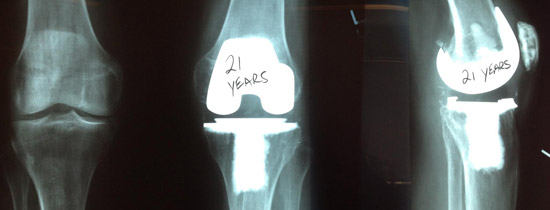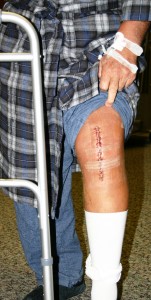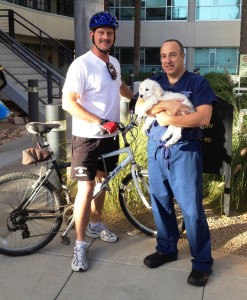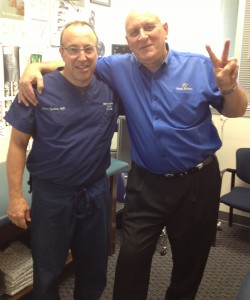A step by step post-operative guide to your recovery after total knee replacement.
Ok so you just had your knee replacement this morning…it hurts a little, but not as bad as you expected…, so now what?
Our patients can expect the following-
We use a femoral nerve block as an additional pain management technique on all of our total knees. This is an injection of a “novacaine” like drug into the groin area pre-op by the anesthesiologist. This numbs the femoral nerve, and greatly reduces the pain you feel for up to 26 hours. It also makes the quadriceps muscle weak until the block wears off, so you have to hold on to your walker to prevent a fall. Patients usually have a “spinal” anesthetic which will decrease pain and narcotic use. Patients recover faster after the spinal then they do with a general anesthetic. (Patients remain more alert and they have less nausea and less fatigue.) Our total knee patients walk one hour after surgery.
We try to avoid narcotic medications as much as possible early on. They have side effects of nausea, constipation, and lethargy. We use non-narcotic medications such as Toradol (a strong NSAID like motrin), IV Tylenol, Celebrex, Ultram, and Naprosyn as well as muscle & anxiety relaxers like ativan, xanax, and librium. Much of the hospital care centers on pain management and immediate rehab, to get you going.
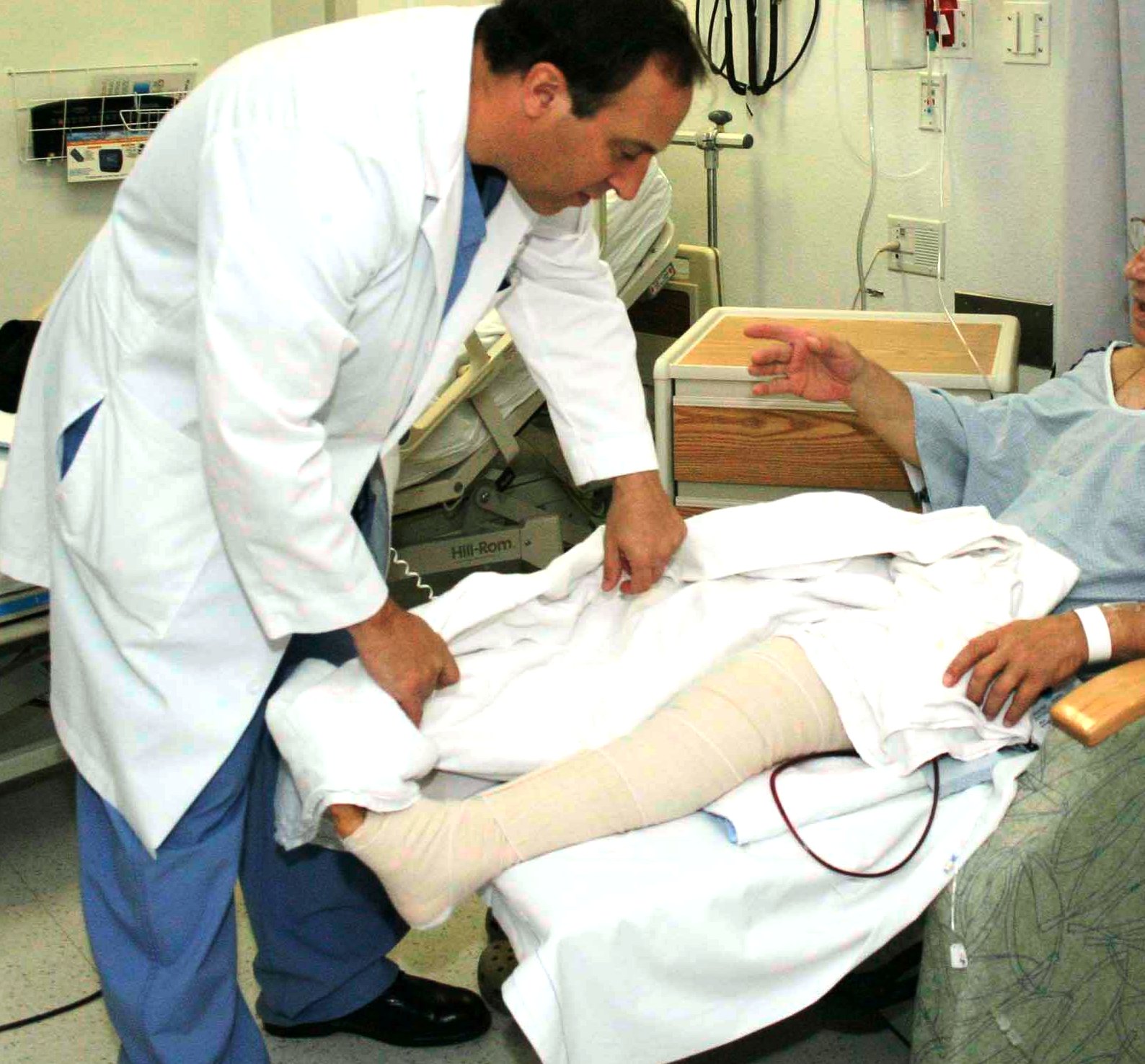
Dr. Stuart Kozinn visiting a post op total knee patient at the Scottsdale Healthcare Total Joint Center. Our patients walk immediately after surgery and sit in a chair moving their legs until bed time.
Our patients will be walking on the Joint Center floor ( 6 West at Scottsdale Osborn) within two hours of the surgery. This also GREATLY decreases the risk of clotting in the veins. Our DVT rate is less than one percent with this early motion protocol. We also use aspirin or Coumadin as a blood thinnner, depending on the risk and special circumstances. Most patients will be discharged on two aspirins a day for 30 days. A foley catheter in the bladder is removed on day one. Some patients are having the surgery without the catheter if they choose to. The catheter does allow us to measure urine output which is an accurate indicator of overall body function. It is hard for some people to get to the bathroom immediately after surgery, and so it is a matter of convenience as well. (The anesthetic medications and the spinal anesthetic often make it harder to urinate initially!).
All patients get 24 hours of IV antibiotics to prevent infection. ( Infections are rare, and our infection rate is about 1/200 or .5%, and appears mostly to be a matter of “bad luck”). The most important thing patients can do to prevent infection is to CALL US if there is any wound drainage after they go home. Also avoiding the bath tub and pool is important until the wound is sealed.
Some younger patients will go home on the day after surgery. Most Total knees elect to stay an extra day however, as the nerve block wears off and the more “normal” pain returns. Total knees hurt more than Total hips, mostly because of the need to BEND the knee (and repaired quadriceps muscle) as soon as possible. Physical therapy starts in the hospital on the day of surgery. You may bear full weight with the walker. It is rare for patients to go to a nursing home or rehab facility unless they are elderly or frail, or have nobody to help them a little at home.
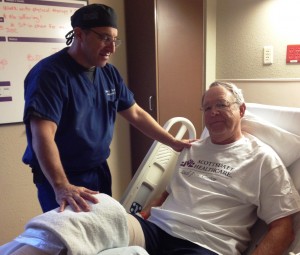
Patients are happier without all the narcotic medications that often make you feel sick and lethargic.
Outpatient physical therapy will be arranged for you at your convenience. We do have our own rehab center at our office, ( and one advantage of doing it there is we are around to keep a closer eye on your progress.) You can however have PT anywhere in the valley that is convenient for you. Most patients stop taking narcotic pain pills after the second week. Motrin and Tylenol work well after that.
You can go back to work (depending on your job) whenever you choose to. I have many total knee patients back in the office part-time after one week. You can play golf at 6 weeks and tennis at 10 weeks post op in most cases. You can drive your care when you are a safe driver. usually one week after a left total knee, and three weeks after a right knee surgery. Over 90% 0f patients will be very happy with their new knee. However, it has recently been shown that about 10% of patients still have some reservations about the knee or pain with some activities. We try to lower expectations to some extent, as a TOTAL KNEE is not a normal knee (after all it is a metal and plastic device that your body must adapt to!). I must say that it is my observation that most patients continue to improve for over a year after surgery.
We used to ask patients to come back for a follow-up visit yearly, but most do so well that seems to be “over-treatment”. You should come back once at a year out for an xray to detect anything unusual, and then after that you may follow up only as needed. You can expect your total knee to last about twenty five years, however it may last less or longer in any particular individual. The best explanation for longevity that I have heard is that one knee out of a undred will fail per year over the long term. That means if one hundred patients had their knees replaced on the same day, 85+ would still be happy with their knee function 20 years later. As many as 20 patients over 25 years may have had the knee revised due to a variety of possible failure mechanisms. The most common causes of gradual knee “failure” are: loosening of the cement bond, and stretching of ligaments with resulting instability or “giving way” of the knee. Lessor causes for failure are infection (.5%), fracture (.1%), loss of knee motion (.2%). The good news is that re-do or REVISION Total Knee Replacement has excellent results as well. This is why younger patients are choosing to get their knees fixed sooner. I often say “the next ten years of your life are your best ten years”, and so I am usually optimistic that Total Knee Replacement is the best option for disabling knee arthritis.
Brian williams from NBC News is having his knee replaced soon – watch this video that he made on the topic! Link to NBC Nightly News
Please come in to our office to see us if you have other questions!
Stuart C. Kozinn MD – Medical Director Scottsdale Joint Center
www.ScottsdaleJointcenter.com




